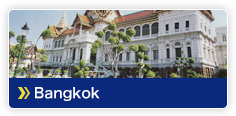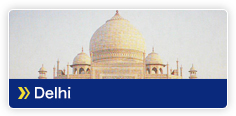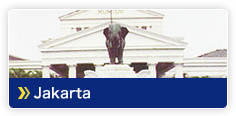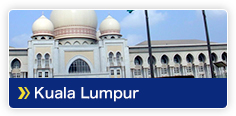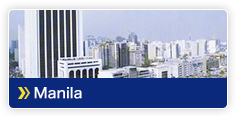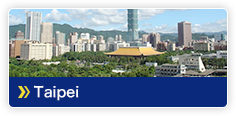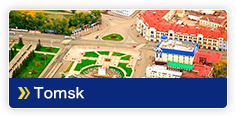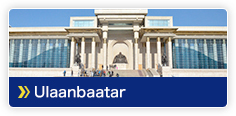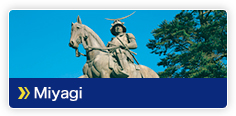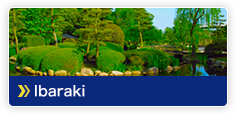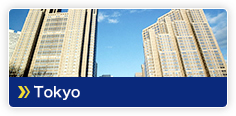Participating cities
- HOME
- Participating cities
Participating cities
Bangkok
 Bangkok Metropolis, the capital of Thailand, is located on a low plain of the Chao Phraya River which extends to the Gulf of Thailand. It is a tropical land, high in temperature and rather humid. The climate is dominated by the monsoon. There are three main seasons rainy, cool and hot. Bangkok Metropolis is the growth pole of the Central Region with a total area of 1,568.74㎢. It is the centre of commerce, industry, national culture, and most important of all, the centre of government administration.
Bangkok Metropolis, the capital of Thailand, is located on a low plain of the Chao Phraya River which extends to the Gulf of Thailand. It is a tropical land, high in temperature and rather humid. The climate is dominated by the monsoon. There are three main seasons rainy, cool and hot. Bangkok Metropolis is the growth pole of the Central Region with a total area of 1,568.74㎢. It is the centre of commerce, industry, national culture, and most important of all, the centre of government administration.
Delhi
 Delhi, the capital of India is a city of history and antiquity.
Despite this historical foundation it is very much a contemporary or modern city. It is not only the seat of highest institutions of legislature, executive, judiciary, but also the industrial and educational centre.
People belonging to various religious sects, castes, linguistic roots residing in Delhi bear testimony to the cosmopolitan character of the city. Temples, churches, and mosques co-exist in harmony and reverence, fairs and festivals are celebrated in an atmosphere of joy and mutual respect in this city.
Delhi is well connected by roads, rail and air with all parts of India. The map of the city is dotted with a number of historical monuments, the important ones being Lal Qila, Jama Masjid, Qutub Minar, India Gate, Humayun Tomb, Lotus Temple, etc.
Delhi continues to live on as a seat of wisdom, land of serenity, and the gateway of India's rich cultural heritage and traditions.
Delhi, the capital of India is a city of history and antiquity.
Despite this historical foundation it is very much a contemporary or modern city. It is not only the seat of highest institutions of legislature, executive, judiciary, but also the industrial and educational centre.
People belonging to various religious sects, castes, linguistic roots residing in Delhi bear testimony to the cosmopolitan character of the city. Temples, churches, and mosques co-exist in harmony and reverence, fairs and festivals are celebrated in an atmosphere of joy and mutual respect in this city.
Delhi is well connected by roads, rail and air with all parts of India. The map of the city is dotted with a number of historical monuments, the important ones being Lal Qila, Jama Masjid, Qutub Minar, India Gate, Humayun Tomb, Lotus Temple, etc.
Delhi continues to live on as a seat of wisdom, land of serenity, and the gateway of India's rich cultural heritage and traditions.
Hanoi
 Hanoi is the capital of the Socialist Republic of Vietnam, the political, cultural, scientific and technical centre of the country.
Hanoi is an ancient settlement of more than two millennia with more than 2000 historical and cultural remains. The long standing culture has been existing and developing together with the building and development of Vietnam. "Thang Long" became independent around the year 1010 and was the capital of many dynasties. Since achieving independence Hanoi became the capital city of the Socialist Republic of Vietnam. Nowadays, nearly 70% of Vietnam's universities are located in Hanoi.
The GDP has been grown at yearly rate of 11.6% from 1991 to 2000. During the 1996-2000 period, the export turnover had been 14.91% per year.
Hanoi has been step by step eliminating the poverty (the figure of 2000 is registered only by 5%). By the end of 1999, all children had access to the secondary school. The city has achieved the natural population growth rate by 1.09% in the year 2000.
Hanoi is the capital of the Socialist Republic of Vietnam, the political, cultural, scientific and technical centre of the country.
Hanoi is an ancient settlement of more than two millennia with more than 2000 historical and cultural remains. The long standing culture has been existing and developing together with the building and development of Vietnam. "Thang Long" became independent around the year 1010 and was the capital of many dynasties. Since achieving independence Hanoi became the capital city of the Socialist Republic of Vietnam. Nowadays, nearly 70% of Vietnam's universities are located in Hanoi.
The GDP has been grown at yearly rate of 11.6% from 1991 to 2000. During the 1996-2000 period, the export turnover had been 14.91% per year.
Hanoi has been step by step eliminating the poverty (the figure of 2000 is registered only by 5%). By the end of 1999, all children had access to the secondary school. The city has achieved the natural population growth rate by 1.09% in the year 2000.
Hong Kong
 Hong Kong, consisting of Kowloon Peninsula, the island of Hong Kong and the New Territories, lies along the coast in the southeast of Guangdong Province, China. The area covering about 1,100 square kilometers is populated with 7.1 million people. Its official name is the Hong Kong Special Administrative Region (SAR) of China.
Hong Kong, consisting of Kowloon Peninsula, the island of Hong Kong and the New Territories, lies along the coast in the southeast of Guangdong Province, China. The area covering about 1,100 square kilometers is populated with 7.1 million people. Its official name is the Hong Kong Special Administrative Region (SAR) of China.
Hong Kong Island lies true south of Kowloon across Victoria Harbor while the New Territories on the adjoining mainland is north of Kowloon. It also includes 262 islands in the South China Sea.
Hong Kong Island was ceded to Britain in 1842. Back then, fishing villages scattered around “rocky wastelands.” It has now developed into the trade and financial hub. Even after it was handed back to China in 1997. Hong Kong still continues to pursue further development under the “one country. two systems” policy.
Jakarta
 Jakarta is the capital of the Republic of Indonesia, and is one of the 30 provinces in Indonesia which Local Government chaired by a Governor. Jakarta is one of the fast growing cities in Asia.
In the 14th century it was named Sunda Kelapa as the port of the Pajajaran Kingdom. In 1961 under Government Regulation No. 2 of 1961 in conjunction with Act No. 2 PNPS 1961 the "Local Government of Special Capital City of Jakarta Raya" was established.
Jakarta uniquely is both the seat of national, as well as regional government. Additionally, Jakarta is the social and cultural center of the country with some of the nation's best education, cultural, sport and health facilities.
Jakarta is also the principal gateway to Indonesia. Strategically positioned in the Indonesian archipelago, the Capital City provides the country's best transport services by land, air and sea.
Jakarta is the capital of the Republic of Indonesia, and is one of the 30 provinces in Indonesia which Local Government chaired by a Governor. Jakarta is one of the fast growing cities in Asia.
In the 14th century it was named Sunda Kelapa as the port of the Pajajaran Kingdom. In 1961 under Government Regulation No. 2 of 1961 in conjunction with Act No. 2 PNPS 1961 the "Local Government of Special Capital City of Jakarta Raya" was established.
Jakarta uniquely is both the seat of national, as well as regional government. Additionally, Jakarta is the social and cultural center of the country with some of the nation's best education, cultural, sport and health facilities.
Jakarta is also the principal gateway to Indonesia. Strategically positioned in the Indonesian archipelago, the Capital City provides the country's best transport services by land, air and sea.
Kuala Lumpur
 As a capital city with more than 1.4 million people and 243.65 sq. km, it serves as the nerve centre for the country's various activities including politics, religion, finance, culture, sports and education. Kuala Lumpur has grown into a vibrant cosmopolitan with a balance mix of multi races blending in harmony with the old and new architecture.
Kuala Lumpur has progressed to become a leading international commercial and financial centre in the region. Today, new landmarks dominate the skyline of Kuala Lumpur, which includes one of the world's tallest buildings, the Petronas Twin Tower and telecommunication tower, the Kuala Lumpur Tower.
Kuala Lumpur will continue not only to develop to strive for economic wealth and physical efficiency but also to meet the social, cultural and spiritual needs of its people and to ensure environmental sustainability and to make it "a world class city for all".
As a capital city with more than 1.4 million people and 243.65 sq. km, it serves as the nerve centre for the country's various activities including politics, religion, finance, culture, sports and education. Kuala Lumpur has grown into a vibrant cosmopolitan with a balance mix of multi races blending in harmony with the old and new architecture.
Kuala Lumpur has progressed to become a leading international commercial and financial centre in the region. Today, new landmarks dominate the skyline of Kuala Lumpur, which includes one of the world's tallest buildings, the Petronas Twin Tower and telecommunication tower, the Kuala Lumpur Tower.
Kuala Lumpur will continue not only to develop to strive for economic wealth and physical efficiency but also to meet the social, cultural and spiritual needs of its people and to ensure environmental sustainability and to make it "a world class city for all".
Manila
 Metro Metropolitan Manila is home to roughly 20% of the country's 76.5 million Filipinos. Its capital, the City of Metropolitan Manila is at the heart of a natural harbor -the Manila Bay of world-famous sunsets. Malacanang Palace, the official residence of the Philippine President, stands regally on the banks of the Pasig River.
Designated as the National Capital Region, Metro Metropolitan Manila is the seat of the national government.
The metropolis is full of expression as a result of the Spanish culture brought about by the rule of Spain that lasted for more than 300 years and the influences from the 50-year rule of the United States. This is apparent in churches, parks and other historical and scenic areas.
Metro Metropolitan Manila, considered as the 18th largest metropolitan area in the world, has contiguous areas of 13 cities and four municipalities, each independently managed. These localities serve as sites for 90% of the country's private business, cultural and medical establishments.
Metro Metropolitan Manila is administered by the Metro Metropolitan Manila Development Authority (MMDA), headed by Chairman Bayani F. Fernando.
Metro Metropolitan Manila is home to roughly 20% of the country's 76.5 million Filipinos. Its capital, the City of Metropolitan Manila is at the heart of a natural harbor -the Manila Bay of world-famous sunsets. Malacanang Palace, the official residence of the Philippine President, stands regally on the banks of the Pasig River.
Designated as the National Capital Region, Metro Metropolitan Manila is the seat of the national government.
The metropolis is full of expression as a result of the Spanish culture brought about by the rule of Spain that lasted for more than 300 years and the influences from the 50-year rule of the United States. This is apparent in churches, parks and other historical and scenic areas.
Metro Metropolitan Manila, considered as the 18th largest metropolitan area in the world, has contiguous areas of 13 cities and four municipalities, each independently managed. These localities serve as sites for 90% of the country's private business, cultural and medical establishments.
Metro Metropolitan Manila is administered by the Metro Metropolitan Manila Development Authority (MMDA), headed by Chairman Bayani F. Fernando.
Seoul
 Seoul rates as one of the largest cities in the world with a population of 10.3 million. It has one of the highest population densities in the world ranking with Barcelona and Paris. Although Seoul has high-rise buildings, a heavily concentrated population along with various urban problems, in 1994 when it celebrated its 600th anniversary as Korea's capital, its centuries-old royal palaces, temples, pagodas and imposing stone gateways set in huge traditional gardens still remained timely and elegant. Seoul is not only the political, economic and educational hub of Korea, but will surely make major contributions to the economic development of Northeast Asia in the 21st century.The large-scale Namdaemun and Dongdaemun Markets, not only serve Seoul citizens but also function as nationwide wholesale markets.
Seoul rates as one of the largest cities in the world with a population of 10.3 million. It has one of the highest population densities in the world ranking with Barcelona and Paris. Although Seoul has high-rise buildings, a heavily concentrated population along with various urban problems, in 1994 when it celebrated its 600th anniversary as Korea's capital, its centuries-old royal palaces, temples, pagodas and imposing stone gateways set in huge traditional gardens still remained timely and elegant. Seoul is not only the political, economic and educational hub of Korea, but will surely make major contributions to the economic development of Northeast Asia in the 21st century.The large-scale Namdaemun and Dongdaemun Markets, not only serve Seoul citizens but also function as nationwide wholesale markets.
Singapore
 Singapore is a vibrant, multi-cultural city-state, and the financial centre of Asian and Pacific region. It possesses a highly-developed infrastructure with world-class airport and port facilities and an excellent communications network linking it to the rest of the world. Singapore needs technology and creativity to overcome the challenges of its limited land resource and growing city. For example, it is exploring the development of high-rise, high-density developments, implementing a deep tunnel sewerage system, and encouraging high-rise greenery. Apart from being an important oil refining and distribution centres and a major supplier of electronic components, Singapore is also developing its capabilities in research and development.
The four official languages in Singapore are Malay, Mandarin, Tamil and English. English is the language of business and administration and is widely spoken.
Singapore is a vibrant, multi-cultural city-state, and the financial centre of Asian and Pacific region. It possesses a highly-developed infrastructure with world-class airport and port facilities and an excellent communications network linking it to the rest of the world. Singapore needs technology and creativity to overcome the challenges of its limited land resource and growing city. For example, it is exploring the development of high-rise, high-density developments, implementing a deep tunnel sewerage system, and encouraging high-rise greenery. Apart from being an important oil refining and distribution centres and a major supplier of electronic components, Singapore is also developing its capabilities in research and development.
The four official languages in Singapore are Malay, Mandarin, Tamil and English. English is the language of business and administration and is widely spoken.
Taipei
 Located in northern Taiwan, Taipei is the political, economic, financial, and cultural center of Taiwan. It has a thriving arts and academic scene and countless modern commercial buildings. Taipei is blessed with a warm climate and is a town of large-hearted people and bountiful nature. With its vibrant cultural and economic growth, it has become a modern international metropolis.
Taipei has it all: scenic mountains and rivers, history-laden relics, a rich diversity of artistic performances, delectable cuisine from all over China, a limitless communications network, a fast and convenient transportation system... These are what qualify Taipei as a "world-class city"; these are also what makes everyone who has visited Taipei, has lived in Taipei, or still lives in Taipei fall in love with the city. Taipei always welcomes everyone to experience first-hand its warmth and vibrancy.
Located in northern Taiwan, Taipei is the political, economic, financial, and cultural center of Taiwan. It has a thriving arts and academic scene and countless modern commercial buildings. Taipei is blessed with a warm climate and is a town of large-hearted people and bountiful nature. With its vibrant cultural and economic growth, it has become a modern international metropolis.
Taipei has it all: scenic mountains and rivers, history-laden relics, a rich diversity of artistic performances, delectable cuisine from all over China, a limitless communications network, a fast and convenient transportation system... These are what qualify Taipei as a "world-class city"; these are also what makes everyone who has visited Taipei, has lived in Taipei, or still lives in Taipei fall in love with the city. Taipei always welcomes everyone to experience first-hand its warmth and vibrancy.
Tomsk
 The City of Tomsk was founded in 1604 as one of the outposts of Russian advent to Siberia populated by Mongol tribes at that time. Soon after it become the administrative center of huge Siberian territory.
The City of Tomsk was founded in 1604 as one of the outposts of Russian advent to Siberia populated by Mongol tribes at that time. Soon after it become the administrative center of huge Siberian territory.
Nowadays Tomsk is one of major Russian research and educational centers. It hosts 6 state universities, including the oldest one in the Asian part of Russia, and 11 research institutes of the Russian Academy of Sciences. Tomsk is among the top ten Russian regions in production of oil and gas. The share of oil and gas industry in the Gross Regional Product is about 30%.
One of the long-term goals of Tomsk Region development is to transform resource based economy to the one based on technology. This objective was set in the mid 1990s and one of the results of these endeavors is the creation of Tomsk Special Economic Zone (SEZ) of Research and Innovation Type in 2005. Nokia Siemens Networks is already building its production facilities in Tomsk SEZ, where some other international companies have located their R&D departments.
Tomsk is a cozy city with tolerant and open-minded people. Tomsk culture is characterized by a balanced combination of traditions and customs of indigenous peoples of Siberia, Russian settlers and representatives of numerous national diasporas (Poles, Germans, Greeks, Estonians etc). Tomsk unique wooden architecture is famous far beyond Russian borders.
Ulaanbaatar
 Ulaanbaatar, the capital of Mongolia, is the main gate for trips to any destination within Mongolia. Ulaanbaatar is located on the bank of the Tuul River and surrounded by four mountains. Well-known as a sunny, peaceful and open city, Ulaanbaatar is a city of contrasts where modern life comfortably blends with Mongolian traditional lifestyle.
Ulaanbaatar, the capital of Mongolia, is the main gate for trips to any destination within Mongolia. Ulaanbaatar is located on the bank of the Tuul River and surrounded by four mountains. Well-known as a sunny, peaceful and open city, Ulaanbaatar is a city of contrasts where modern life comfortably blends with Mongolian traditional lifestyle.
Population of Ulaanbaatar city has been growing so rapidly that the population of the city has nearly doubled since 1986.
Yangon
 The Nation's richest seaport and major city, Yangon was once known for its beauty and cleanliness. With it's tree-lined streets, shaded parks and gardens and big lakes, the city was labeled as the "PRINCESS OF ASIA".
Originally a small fishing village named Dagon, it was renamed Yangon meaning "END OF STRIFE" after King Alaungpaya conquered lower Myanmar in 1755. The British refounded and its name changed to Rangoon. Rangoon became the capital city of Myanmar when the country regained its independence on 4th January 1948. The original name Yangon has been restored after the advent of the State Law and Order Restoration Council in 1988. Today the city covers an area of 300 sq miles, comprising 33 townships.
Yangon wears a look of prosperity beyond recognition, with new high-rises such as condominiums, hotels, plazas, supermarkets and departmental stores.
The Nation's richest seaport and major city, Yangon was once known for its beauty and cleanliness. With it's tree-lined streets, shaded parks and gardens and big lakes, the city was labeled as the "PRINCESS OF ASIA".
Originally a small fishing village named Dagon, it was renamed Yangon meaning "END OF STRIFE" after King Alaungpaya conquered lower Myanmar in 1755. The British refounded and its name changed to Rangoon. Rangoon became the capital city of Myanmar when the country regained its independence on 4th January 1948. The original name Yangon has been restored after the advent of the State Law and Order Restoration Council in 1988. Today the city covers an area of 300 sq miles, comprising 33 townships.
Yangon wears a look of prosperity beyond recognition, with new high-rises such as condominiums, hotels, plazas, supermarkets and departmental stores.
Iwate
 Iwate Prefecture lies in the north east of the Tohoku region, and at approximately 15,278.89 ㎢, is the second largest in area after Hokkaido Island and is the largest prefecture in Japan, rivaling, in size, that of the entire island of Shikoku. Iwate’s prefectural government is based in Morioka City. Iwate faces the Pacific Ocean to the east, while the Kitakamigawa river runs from north to south through the middle of the prefecture. In ancient times, the Oshu Fujiwara-shi culture prospered in Hiraizumi, and “Hiraizumi - the Temples, Gardens and Archaeological Sites Representing the Buddhist Pure Land” was registered on the World Heritage List on 26 June 2011 as a result of the 35th UNESCO World Heritage Committee Session.
Iwate Prefecture lies in the north east of the Tohoku region, and at approximately 15,278.89 ㎢, is the second largest in area after Hokkaido Island and is the largest prefecture in Japan, rivaling, in size, that of the entire island of Shikoku. Iwate’s prefectural government is based in Morioka City. Iwate faces the Pacific Ocean to the east, while the Kitakamigawa river runs from north to south through the middle of the prefecture. In ancient times, the Oshu Fujiwara-shi culture prospered in Hiraizumi, and “Hiraizumi - the Temples, Gardens and Archaeological Sites Representing the Buddhist Pure Land” was registered on the World Heritage List on 26 June 2011 as a result of the 35th UNESCO World Heritage Committee Session.
Iwate is also famous as the birthplace of Miyazawa Kenji, the poet who had a deep love for the region, and who coined term "Ihatove” which refers to an imaginary utopia and was inspired by Iwate Prefecture.(Photo:Chuson-ji Temple)
Mityagi
 Miyagi Prefecture lies to the south west of the Tohoku region, and faces the Pacific Ocean. The Kitakamigawa river runs south through the north eastern part of the prefecture, while the Abukumagawa river runs north through the southern part of the prefecture. Miyagi Prefecture is 6,862.10㎢ in size. Sendai City, where the prefectural government is based, has a population of approximately 1.07 million, and is an ordinance-designated city. Sendai is the largest city in the Tohoku region and a convergence point for government offices including national government branches and agencies, as well as corporate headquarters and branch offices. Visitors throng to Sendai in summer for the famous Sendai Tanabata Festival, one of the three major festivals of the Tohoku region, while Sendai Plain is famous for the great daimyo (feudal lord) Date Masamune dating back to the Sengoku (warring states) period. Today Sendai Plain is one of Japan’s leading grain growing regions, while the Kuroshio (the Japan Current) and the Oyashio (the Chishima Current) converge off the Sanriku coast which extends from central Miyagi Prefecture and along the coastlines of Iwate and Aomori and is renowned for being one of the three largest fishing grounds in the world, filled with schools of bonito and mackerel.
Miyagi Prefecture lies to the south west of the Tohoku region, and faces the Pacific Ocean. The Kitakamigawa river runs south through the north eastern part of the prefecture, while the Abukumagawa river runs north through the southern part of the prefecture. Miyagi Prefecture is 6,862.10㎢ in size. Sendai City, where the prefectural government is based, has a population of approximately 1.07 million, and is an ordinance-designated city. Sendai is the largest city in the Tohoku region and a convergence point for government offices including national government branches and agencies, as well as corporate headquarters and branch offices. Visitors throng to Sendai in summer for the famous Sendai Tanabata Festival, one of the three major festivals of the Tohoku region, while Sendai Plain is famous for the great daimyo (feudal lord) Date Masamune dating back to the Sengoku (warring states) period. Today Sendai Plain is one of Japan’s leading grain growing regions, while the Kuroshio (the Japan Current) and the Oyashio (the Chishima Current) converge off the Sanriku coast which extends from central Miyagi Prefecture and along the coastlines of Iwate and Aomori and is renowned for being one of the three largest fishing grounds in the world, filled with schools of bonito and mackerel.
Fukushima
 Fukushima Prefecture lies in the southernmost end of the Tohoku region. Eastern Fukushima faces the Pacific Ocean, while the Ou Mountains runs longitudinally through the middle of the prefecture, and the Abukumagawa river runs to the north on the eastern side of the Mountains. Fukushima Prefecture expands from east and west, with a total area of approximately 13,782.75㎢, and is the third largest prefecture in the country after Hokkaido and Iwate. Based on terrain, climate, modes of transportation and history, Fukushima can be broadly divided into Hama-dori, on the Pacific Ocean side, Naka-dori, in the center, and Aizu in the west. Lake Inawashiro, which is the fourth largest lake in Japan, lies in the middle of the prefecture. Bandai-san, or Mt Bandai, straddling the three villages and towns of Inawashiro-machi, Bandai-machi and Kitashiobara-mura in Yama-gun, is also referred to as Aizu Fuji or Aizu Bandai-san, and has been selected as one of Japan’s 100 most famous mountains, and is visited by large numbers of sightseers from throughout Japan.
Fukushima Prefecture lies in the southernmost end of the Tohoku region. Eastern Fukushima faces the Pacific Ocean, while the Ou Mountains runs longitudinally through the middle of the prefecture, and the Abukumagawa river runs to the north on the eastern side of the Mountains. Fukushima Prefecture expands from east and west, with a total area of approximately 13,782.75㎢, and is the third largest prefecture in the country after Hokkaido and Iwate. Based on terrain, climate, modes of transportation and history, Fukushima can be broadly divided into Hama-dori, on the Pacific Ocean side, Naka-dori, in the center, and Aizu in the west. Lake Inawashiro, which is the fourth largest lake in Japan, lies in the middle of the prefecture. Bandai-san, or Mt Bandai, straddling the three villages and towns of Inawashiro-machi, Bandai-machi and Kitashiobara-mura in Yama-gun, is also referred to as Aizu Fuji or Aizu Bandai-san, and has been selected as one of Japan’s 100 most famous mountains, and is visited by large numbers of sightseers from throughout Japan.
(Photo: SIGHTS in FUKUSHIMA JAPAN
[Tourism Information Of Fukushima Prefecture)
Ibaraki
 Ibaraki Prefecture lies in the north eastern section of the Kanto region, with the eastern part facing the Pacific Ocean, and the Tone river - with the largest basin area in Japan - flowing east into the region that borders Chiba Prefecture to the south. Ibaraki Prefecture is 6,095.69㎢ in area. Ibaraki’s vast plateau and long coastline are major factors behind the development of Ibaraki’s agricultural and fishing industries. In recent years, however, the prefecture has been undergoing a transformation into an advanced industrial prefecture as the result of the establishment of a coastal industrial zone, an advanced science research center and an international harbor city. Meanwhile, the south of the prefecture is being developed to become bedroom suburbs of Tokyo, playing a role in the function of Tokyo Metropolis. Mito city, where the prefectural government is based, is famous for Mito Komon (Tokugawa Mitsukuni), a member of the great Tokugawa family of the Edo period and who was renowned for his extensive travels through Japan. Mito is also famous for the Kairakuen gardens featuring plum blossoms, and for natto (fermented soy beans) production which became widespread after the Meiji period, with “natto from Mito” a familiar food product among the Japanese.
Ibaraki Prefecture lies in the north eastern section of the Kanto region, with the eastern part facing the Pacific Ocean, and the Tone river - with the largest basin area in Japan - flowing east into the region that borders Chiba Prefecture to the south. Ibaraki Prefecture is 6,095.69㎢ in area. Ibaraki’s vast plateau and long coastline are major factors behind the development of Ibaraki’s agricultural and fishing industries. In recent years, however, the prefecture has been undergoing a transformation into an advanced industrial prefecture as the result of the establishment of a coastal industrial zone, an advanced science research center and an international harbor city. Meanwhile, the south of the prefecture is being developed to become bedroom suburbs of Tokyo, playing a role in the function of Tokyo Metropolis. Mito city, where the prefectural government is based, is famous for Mito Komon (Tokugawa Mitsukuni), a member of the great Tokugawa family of the Edo period and who was renowned for his extensive travels through Japan. Mito is also famous for the Kairakuen gardens featuring plum blossoms, and for natto (fermented soy beans) production which became widespread after the Meiji period, with “natto from Mito” a familiar food product among the Japanese.
Tokyo
 Tokyo has a 400-year history as the capital of Japan that started at the beginning of the Edo period. During this time, it suffered from earthquakes and war, but in the postwar period it was the driving force behind Japan's miraculous economic growth. Today, about 12 million people, nearly 10 percent of the nation's population, live, work, rest and learn in Tokyo.
Tokyo has advanced in all fields, such as politics, economy and culture, and is the center of Japan's economy and society.
On the other hand, urban problems, for example, decline of business vitality, chronic traffic congestion and aggravation of the environment, are all setbacks for Tokyo. Now the city has been set the task to realize that Tokyo is vibrant and appealing, where people, goods, and information interact in a global city that boasts a great numbers of residents and visitors.
Tokyo has a 400-year history as the capital of Japan that started at the beginning of the Edo period. During this time, it suffered from earthquakes and war, but in the postwar period it was the driving force behind Japan's miraculous economic growth. Today, about 12 million people, nearly 10 percent of the nation's population, live, work, rest and learn in Tokyo.
Tokyo has advanced in all fields, such as politics, economy and culture, and is the center of Japan's economy and society.
On the other hand, urban problems, for example, decline of business vitality, chronic traffic congestion and aggravation of the environment, are all setbacks for Tokyo. Now the city has been set the task to realize that Tokyo is vibrant and appealing, where people, goods, and information interact in a global city that boasts a great numbers of residents and visitors.
Contact Information
Asia Junior Sports Exchange Games 2014 information desk
TEL: 03-6257-1948 (weekday:10:00 - 18:00)






